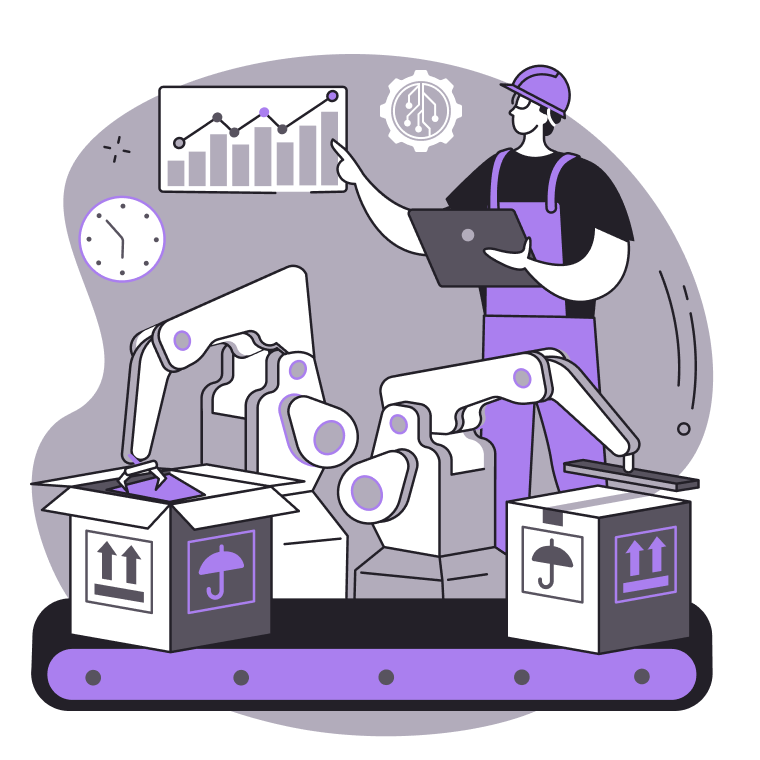On This Page:
As artificial intelligence (AI) becomes more sophisticated, manufacturing companies are increasingly turning to technology for innovative ways to streamline processes and improve efficiency. Manufacturing and AI have a natural synergy: manufacturing companies generate more data than any other sector of the economy, and AI is a technology that synthesizes data in order to make better and faster decisions than a human could. Several manufacturing companies have already achieved noteworthy success as early adopters of AI innovations, and industry experts are encouraging manufacturers to treat AI as essential to their long-term viability and growth. Adopting AI marks an exciting and transformative moment in the life of a manufacturing company.
Unlocking Efficiency
Manufacturers operate as part of a complicated global supply chain, with raw materials and component parts often traveling all over the world for different stages of the manufacturing process before being assembled into the final product and ready to be sold.
For a manufacturing business to run smoothly, it needs to master the supply chain, ensuring that the right amounts of raw materials arrive at the right factory, at the right time. Materials must be assembled correctly into a sellable product and final products sent to the places and at the times where consumer demand is highest. Many of the most successful early adopters of manufacturing AI have used the technology to unlock efficiency in these areas. For example:
Reducing steel scrap rates at NIM Group
NIM Group is a manufacturer of technologically advanced carbon steel. Each customer has specific requirements (like strength, flexibility, and shape) that must be met for the steel to be usable. If NIM’s steel fails to meet a customer’s requirements, it must be scrapped—and that costs money. Historically, NIM relied on human operators’ knowledge and experience to determine the machine settings for processing specific types of steel. That resulted in a lot of error and waste. It could also take a long time to train new operators and get them up to speed.
NIM brought in AI technology to help them predict the best machine settings for processing different types of steel. Now every time they make a batch of steel, they get new data about the settings they used and the quality of product they obtained that help them refine their process even further for the next time. Using AI, NIM Group has significantly reduced the amount of steel that gets scrapped—and they’ve also reduced the amount of time it takes to train new operators.
Forecasting demand at IKEA
Furniture manufacturer IKEA sells its products in 460 stores located in 63 countries across the world. And at every single one of these stores, demand for specific products can vary dramatically from one week to the next, depending on local factors like weather, festivals, and when people get paid.
If IKEA doesn’t get it right, it might wind up running out of products at one store, while the same product sits unsold at another somewhere else in the world. And that failure to send the right products to the right stores at the right time can have upstream effects on IKEA’s manufacturing process. For example, its suppliers might buy raw material for a product based on its performance at one store, but then wind up with too much of that raw material after the product fails to sell at other stores.
IKEA has been using AI to develop its understanding of local demand at each of its stores. By understanding at a granular level what each store’s customers are looking for, and at what times, IKEA can make better decisions all the way up its supply and manufacturing chain: what products to make, in what quantity, and where to send them.
Predictive maintenance at Mondi
Many manufacturing companies rely on special equipment to produce their products, and maintaining that equipment can be a source of inefficiency. It’s costly when a machine breaks and must be repaired—but scheduling preventive maintenance can also be costly, if it means shutting down production in order to perform maintenance tasks that aren’t really necessary. Clearly the most efficient approach would be to perform maintenance when and only when it’s needed to prevent breakage.
Plastic manufacturer Mondi has been using a type of AI called predictive maintenance to help it make decisions about when to stop production in order to maintain its plastic-making equipment. Using pressure and temperature sensors on the machines, they feed data into its AI software, which issues alerts when it recognizes unhealthy trends so that repairs can be performed just in time. Using predictive maintenance, Mondi has significantly reduced machine downtime and waste of raw materials, resulting in savings for the company of over $53,000 dollars per year.
Challenges in Adopting AI
Based on examples like these, many manufacturing companies are understandably excited about adopting AI techniques. However, while the potential benefits that come with an AI approach to manufacturing are enormous, the process of shifting to AI is challenging, and companies can stumble if they get it wrong.
Some of the risks include committing to an AI provider that doesn’t understand or mesh with the company’s needs, beginning a shift to AI before the company’s leadership is fully committed, and failing to connect enough consistent, meaningful data for the AI to yield helpful results.
For those manufacturing companies that get it right, though, AI unlocks enormous potential. In the complex, global, interconnected world of 21s century manufacturing, AI helps manufacturers see how small details shape the big picture so they can make the best possible decisions for growth, profit, and success.

